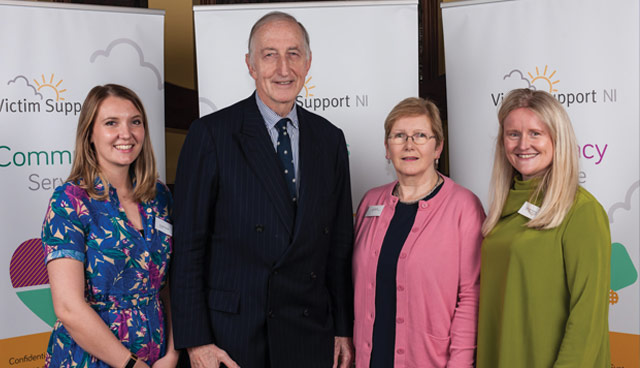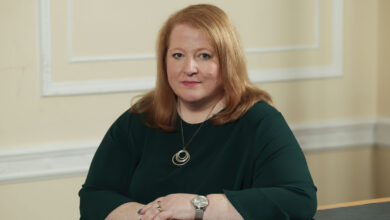Systemic change needed to improve the system for victims

Geraldine Hanna, CEO of Victim Support NI, formed part of The Gillen Review advisory panel. In this article, she provides an overview of Victim Support NI’s response to the preliminary report.
Victim Support NI has been working alongside Northern Ireland’s criminal justice system for almost 40 years, and over that time we have seen many changes to the way the system meets the needs of victims and witnesses. These needs are now part of legislation with victims’ rights protected in law by the Victim Charter. The Gillen Review helpfully charts changes in the criminal justice system, legislative change in particular, but also changes in how victims of sexual crime are treated.
Despite these changes however, reporting and conviction levels for sexual violence cases remain low. Figures indicate that of all rape offences reported to police, 6 per cent result in conviction. Of all rape cases disposed of at Crown Court, 24 per cent result in a guilty verdict compared with over 88 per cent for other Crown Court offences. Layered on top of this is the fact that over 40 per cent of cases drop out of the system before they get to the door of the court and an estimated 83 per cent of victims never come forward to report in the first place. In light of this, it is of little surprise to many that Gillen, in his preliminary report, judges the system to be “badly in need of urgent and extensive repair” and suggests 220 proposed recommendations for change.
Victim Support NI believe that we need bold and comprehensive reform if we are to deliver on the systemic change Gillen refers to and build confidence in victims of these crimes. Time and again Victim Support NI staff and volunteers encounter individuals who are disillusioned with, or mistrustful of, the justice system. One respondent to an online survey which the charity issued to gauge the opinion of victims on the report comments:
“Nothing would convince me to report what happened. There is simply no point and it would cause too much heartache to others.”
Another, who did report the incident notes:
“I would not report this type of crime again if it were to happen again because the likelihood of prosecution is so low and the justice system can feel like being raped all over again.”
Crimes of a sexual nature stand apart because of the intimacy with which they must be examined and described, because of their interpersonal nature, because very often it is one individual’s word against another with no corroborating evidence and because of the lifetime impact trying these cases can have on all concerned. In recent times concerns about social media, conviction rates and most significantly the influence of rape myths and stereotypes has called into question the suitability of our current jury system in dealing with these cases.
Research has indicated how prevalent rape myths are within society. A recent YouGov survey commissioned for the End Violence Against Women Coalition in December 2018 revealed worrying views of sexual violence and a lack of understanding of the law surrounding it. Key findings include:
• a third (33 per cent) of the almost 4,000 respondents think it isn’t usually rape if a woman is pressured into having sex but there is no physical violence;
• a third of men think if a woman has flirted on a date it generally wouldn’t be rape, even if she hasn’t consented to sex (21 per cent of women believe this);
• almost a quarter (24 per cent) don’t think that, in most cases, sex without consent in long-term relationships is rape (despite laws against rape in marriage being in place since 1991); and
• around one in 10 are unsure or think it’s usually not rape to have sex with a woman who is asleep or too drunk to consent.
Rape myths and stereotypes sit within the realm of unconscious bias. It is the very unconscious nature of those myths and stereotypes that makes them so powerful and also dangerous and difficult to address. Our charity welcomes Gillen’s attempts to combat rape myths but we ask if this will be sufficient to address the powerful, automatic responses people have, especially in a highly pressurised and, for juries, alien environment. Following considered debate, Victim Support NI believes that a judge-led panel of experts will deliver the best outcome for victims, defendants and justice overall.

Whilst many argue that trial by jury is the cornerstone of the adversarial process, judge-led panels are already an established part of our criminal justice system. This can be seen in our Youth courts which operate to an established body of rules (including restrictions to members of the public) which could be easily replicated. This model takes consideration of the vulnerability of the accused and is an accepted mechanism within our current system. Given the distinct issues that separate sexual violence from other crime types and the human rights standards in which victims of sexual and gender-based violence are considered ‘vulnerable’, we believe that a similar position can be taken. Rather than undermining our faith and trust in the jury system as a premise, the adaptation of the system to address identified challenges in these cases alone could serve to curb the growing sense of discontent with the current model which Gillen notes in the report.
Through this one change, many of the issues identified in the report such as delay, impact of social media, jury understanding of the law on consent and reasonable doubt could be significantly improved, thereby increasing public confidence. Confidence in this system, and in particular, confidence in the integrity of the decision-making process is vital if we are to successfully address the significant issues identified in the report and encourage victims to actively engage with the criminal justice system. Victim Support NI will therefore be encouraging John Gillen to review this recommendation.
Overall, Victim Support NI welcomes the recommendations emanating from this report. We have no doubt that if all recommendations are adopted in their entirety, the system will improve. Gathering the buy-in, support and commitment from the legal profession and judiciary will be critical if we are to achieve the required cultural and systemic change. Good training, well received and implemented in practice is imperative. Adequate resourcing and timetabling is also essential to ensure the spirit and intention of the recommendations is achieved.
We look forward to a swift implementation of the final recommendations and are ready to play our part in improving the system so that victims report sexual crime with confidence and participate in delivering justice.
If you’ve been affected by sexual violence and would like to speak to someone in confidence, please call Victim Support NI on 028 9024 3133. You can also contact the 24 hour DV/SV helpline on 0808 802 1414






